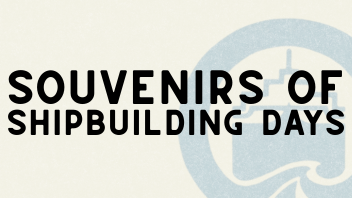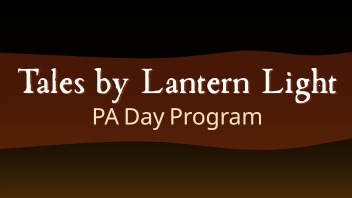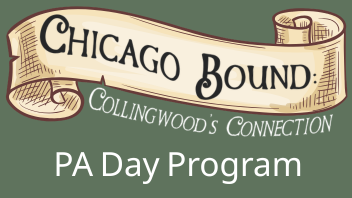Hours of Operation: Tuesday - Saturday, 10:00 a.m. - 4:00 p.m.
Admission to the Collingwood Museum is by donation with a suggested $5 donation per person. Located at 45 St. Paul St. Contact by phone 705-445-4811 ext. 7211 or email museum@collingwood.ca.
Become a Member | Subscribe to Museum Newsletter | 2024 Annual ReportOnline Collection Database | Museum News & Notices | In The News
Temporary Service Disruption: Planned Closure
The Collingwood Museum will be closed for contractor site visits on Wednesday, October 15, 2025, at 3:00 p.m. The Museum will reopen for regular hours of operation on Thursday, October 16, at 10:00 a.m. We appreciate your patience during this planned closure.

Souvenirs of Shipbuilding Days
For more than a century, the Collingwood Shipyards shaped not only the waterfront, but the heart of the town itself. Once known as “the town with the ship at the end of the street,” the sounds of the yard were the rhythm of daily life. As one of Collingwood’s largest employers, the shipyards connected generations of families in a proud tradition that helped define the community’s identity for over 100 years.
This exhibit brings together souvenirs, gifts, and keepsakes that carried the shipyard spirit into homes near and far from glassware, commemorative calendars, postcards, buttons, and more. Some were tokens of appreciation from management; others, personal reminders of a life and legacy built along the shores of Georgian Bay. Each item offers a glimpse into the pride, resilience, and community spirit that defined Collingwood’s shipbuilding story.
On display from September 5 onwards.

Haunted Tour with Dean Hollin
The Collingwood Museum invites you to join staff on a haunted walking tour! You are guaranteed to have a spook-tacular time listening to terrifying tales and ghostly stories as guest host Dean Hollin leads you along the shadowy streets of Collingwood’s Heritage Conservation District. While on the walk, you will hear about ghostly experiences including the smell of cigar smoke and footsteps in a building that once housed the Enterprise Bulletin newspaper, apparitions in the hallways of a former doctor’s house, the tragic story of one of Ontario’s oldest unsolved murders, and other strange sightings.
Evening guided tours will be offered on Friday, October 24, Wednesday, October 29, and Thursday, October 30 at 7:00 p.m. The 2 km walking loop will begin and end at the Collingwood Museum and will take approximately 1.5 hours. This is a ticketed event. Limited tickets are available for $15.00 (plus HST and service fee) and can be purchased online by clicking the button below. Tickets go on sale Tuesday, October 7 at 9:00 a.m.

Tales by Lantern Light October PA Day Program
Step into the glow of lantern light for a morning of mysterious tales and old-time magic! In this Halloween-themed PA Day program, children ages 6 - 12 will discover how stories were told before electricity, using magic lanterns, stereoscopes, and zoetropes to make images dance. We’ll explore curious artifacts and make our very own working zoetrope to take home.
Program runs Friday, October 24, 9:00 a.m. – 12:00 p.m. $15 per child / $12 for members. Preregistration required. Registration opens Wednesday, October 1 at 9:00 a.m. Click the button below to register on PerfectMind or call Museum Staff 705-445-4811 ext. 7223.
Click Here to Register on PerfectMind
The affordable recreation program offers fee assistance for Collingwood residents facing financial barriers, covering activities like swimming, skating, museum day camps, and more—learn and apply on the town's official page.

Chicago Bound: Collingwood's Connection November PA Day Program
Travel back to a time when Collingwood had surprising ties to the bustling city of Chicago! In this PA Day program, children ages 6 - 12 will explore our community’s connection to the famous 1893 Chicago World’s Fair, where groundbreaking inventions, amazing exhibits, and dazzling displays wowed the world. We’ll uncover fascinating stories, see unique artifacts, and create a themed craft to bring a piece of the fair home.
Program runs Friday, November 14, 9:00 a.m. – 12:00 p.m. $15 per child / $12 for members. Preregistration required. Registration opens Wednesday, October 1 at 9:00 a.m. Click the button below to register on PerfectMind or call Museum Staff 705-445-4811 ext. 7223.
Click Here to Register on PerfectMind
The affordable recreation program offers fee assistance for Collingwood residents facing financial barriers, covering activities like swimming, skating, museum day camps, and more—learn and apply on the town's official page.

Museum Membership
Not a member yet? Membership to the Collingwood Museum has its privileges.
Become a member and help support our efforts. In addition to free admission and discounts in the gift shop, members receive monthly e-newsletters that keep you up-to-date on museum projects and events.
To become a member, please fill out the online application linked below. Museum Staff are available to answer any questions you may have in regards to Museum Membership at 705-445-4811.
Click Here for the Online Membership Application

Collection and Research
The museum houses an archival collection that is accessed by researchers from around the world. Photographs of Great Lakes vessels, Collingwood’s historic homes, downtown, and early industries are amongst the most popular items.

Stories from Another Day - A Collingwood Museum Podcast
Stories from Another Day travels through Collingwood's past to find the people, events and stories that made this town into the jewel it is today. Join the Collingwood Museum and host Ken Maher to explore over 160 years of tragedies and triumphs, disasters, and determination.
Check back for new episodes monthly.

Gift Shop
No visit is complete without browsing the Museum’s quaint gift shop. You will find a wide selection of books, games, clothing, small gifts, prints, postcards, and more.
Please come in to the Museum to view available items or call staff with any inquiries.
Virtual Tours

Growing Roots: The Legacy of Smart Bros. Ltd. in Collingwood Self-guided Driving Tour

First World War Virtual Walking Tour
